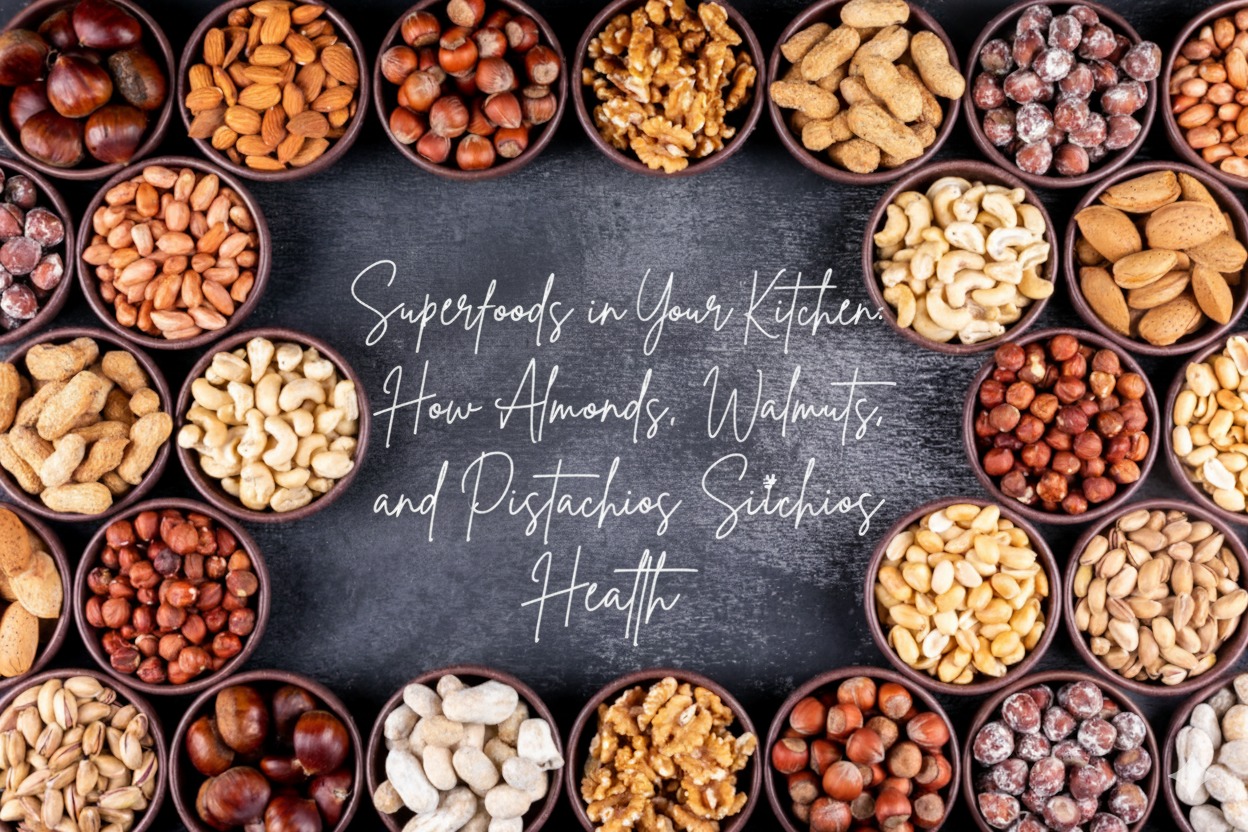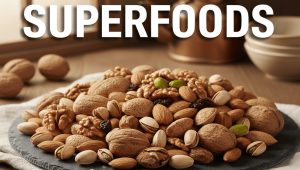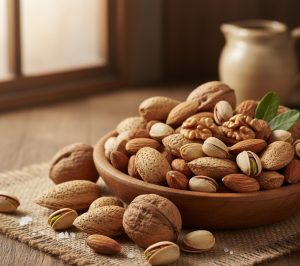Introduction
When we think about superfoods, our minds often jump to exotic berries, imported seeds, or expensive powders. Yet, some of the most powerful superfoods have always been right in our kitchens. almonds walnuts and pistachios are not only accessible but also deeply rooted in history, culture, and tradition. These foods have nourished civilizations for centuries, offering a perfect blend of taste, nutrition, and versatility.
Unlike fad diets or trendy supplements, the benefits of almonds walnuts and pistachios are backed by both ancient wisdom and modern science. They deliver essential nutrients like protein, healthy fats, vitamins, and minerals, making them ideal for anyone—from growing children and busy professionals to athletes and the elderly.
This blog takes you on a comprehensive journey, explaining why almonds walnuts and pistachios deserve a permanent place in your daily diet. We’ll explore their nutritional profiles, cultural significance, health benefits, and practical ways to use them—from simple snacks to gourmet recipes.
Why Focus on almonds walnuts and pistachios?
There are dozens of nuts available worldwide, but almonds walnuts and pistachios stand out for their unique nutritional offerings and wide availability. Here’s why they matter:
- Nutrient Density – Each of these nuts offers a powerful nutrient package. Almonds are rich in vitamin E, walnuts are loaded with omega-3 fatty acids, and pistachios provide a high concentration of antioxidants.
- Cultural Relevance – From Indian sweets like badam halwa and baklava in the Middle East to walnut-stuffed breads in Europe and pistachio ice cream across the globe, these nuts have become central to traditional cuisines.
- Scientific Backing – Numerous studies confirm that regular consumption of almonds walnuts and pistachios supports heart health, improves brain function, balances cholesterol, and even aids in weight management.
- Everyday Versatility – Whether you prefer them raw, roasted, salted, soaked, or blended into smoothies, these nuts adapt to nearly every dietary style.
By focusing on almonds walnuts and pistachios, we highlight not just their individual strengths but also the way they complement each other in building a well-rounded, nutrient-rich diet.
Almonds: The King of Nuts
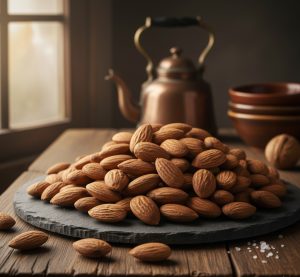
When people think of healthy snacking, almonds often top the list. They are crunchy, flavorful, and among the most popular nuts worldwide. But beyond taste, almonds have earned the title of “King of Nuts” because of their exceptional nutritional profile and long-standing place in human diets.
A Brief History of Almonds
Almonds have been cultivated for thousands of years. Originating in the Middle East and South Asia, they spread along trade routes into Europe and eventually across the globe. Ancient Egyptians considered almonds a delicacy, and they were mentioned in historical texts for their medicinal and culinary uses. In India, almonds are a staple in Ayurvedic traditions, known for improving memory and vitality.
Nutritional Profile of Almonds (per 100g)
- Calories: ~576 kcal
- Protein: 21g
- Fat: 49g (mostly monounsaturated)
- Carbohydrates: 22g
- Fiber: 12g
- Vitamin E: 25mg (over 100% of daily needs)
- Magnesium: 268mg
This nutrient balance explains why almonds are considered one of the most complete foods available.
Health Benefits of Almonds
- Brain Health: In Ayurveda, almonds are known to sharpen memory and concentration. Modern research supports this, linking vitamin E and antioxidants to reduced risk of cognitive decline.
- Heart Protection: Almonds’ monounsaturated fats and magnesium contribute to lower cholesterol and improved heart function.
- Weight Management: Though calorie-dense, almonds actually support weight control by increasing satiety and reducing overeating.
- Skin Glow: Rich in vitamin E, almonds promote skin health, fight free radicals, and slow aging.
- Bone Strength: With high calcium and magnesium, almonds are beneficial for bone density.
Creative Uses of Almonds
- Soaked Almonds: Traditional wisdom recommends soaking almonds overnight to improve digestibility and unlock nutrients.
- Almond Flour: A gluten-free alternative in baking, ideal for pancakes, cookies, and bread.
- Almond Milk: A popular dairy substitute, rich in nutrients and suitable for vegans.
- Snacks: Roasted or lightly salted almonds make a healthier alternative to processed snacks.
- Desserts: Almonds enhance kheer, halwa, baklava, and cakes with flavor and crunch.
Almonds are proof that healthy eating doesn’t need to be boring—they bring richness to both traditional recipes and modern diets.
Walnuts: The Brain-Shaped Superfood
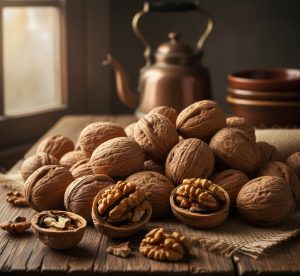
Among all nuts, walnuts are the most distinctive in appearance—their crinkled halves resemble the human brain. It’s no coincidence that traditional medicine linked them to brain health centuries ago. Modern science now confirms that walnuts are a rich source of omega-3 fatty acids and antioxidants, nutrients that directly support cognitive function.
A Brief History of Walnuts
Walnuts are among the oldest tree foods known to humans, dating back more than 7,000 years. They were highly prized by ancient Persians, Greeks, and Romans, who considered them food for the gods. The English later spread walnut cultivation worldwide, giving us the common name “English walnut.”
Nutritional Profile of Walnuts (per 100g)
- Calories: ~654 kcal
- Protein: 15g
- Fat: 65g (high in polyunsaturated fats)
- Carbohydrates: 14g
- Fiber: 7g
- Omega-3 (ALA): 9g
- Copper, Manganese, Magnesium: abundant
Health Benefits of Walnuts
- Brain Function: Walnuts are one of the best plant-based sources of omega-3 fatty acids, which are vital for brain health, memory, and mood regulation.
- Heart Health: The combination of polyunsaturated fats, fiber, and antioxidants lowers LDL cholesterol and reduces cardiovascular risks.
- Anti-Inflammatory Effects: Walnuts contain compounds that reduce inflammation, which is key in preventing chronic diseases like diabetes and arthritis.
- Sleep Support: They are a natural source of melatonin, the hormone that regulates sleep cycles.
- Gut Health: Walnuts encourage the growth of beneficial gut bacteria, improving digestion and immunity.
Creative Uses of Walnuts
- Raw Snack: A handful of walnuts a day supports brain and heart health.
- Walnut Oil: Used in dressings or drizzled over dishes for a nutty flavor and nutrient boost.
- Baking: Essential for brownies, carrot cakes, banana bread, and traditional baklava.
- Salads: Toasted walnuts pair beautifully with greens, apples, and cheese.
- Savory Dishes: Ground walnuts form the base of sauces in Persian and Georgian cuisines.
Walnuts are a shining example of how food can be both delicious and medicinal. Their rich taste and crunchy texture make them versatile, while their nutrient profile makes them indispensable.
Pistachios: The Green Gem of Nutrition
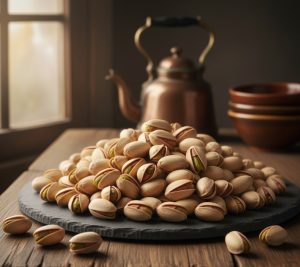
Among nuts, pistachios stand out for their vibrant green color, unique flavor, and cultural significance. Known as the “smiling nut” in Iran and the “happy nut” in China, pistachios symbolize prosperity and joy. Beyond symbolism, they are packed with nutrients, making them one of the most well-rounded snacks available.
A Brief History of Pistachios
Pistachios have been cultivated for more than 9,000 years, originally in the Middle East. They were a delicacy for royalty and nobility, often reserved for special occasions. Ancient travelers carried pistachios on long journeys for energy, while today, they’re enjoyed worldwide—from festive desserts to everyday snacking.
Nutritional Profile of Pistachios (per 100g)
- Calories: ~562 kcal
- Protein: 20g
- Fat: 45g (high in monounsaturated fats)
- Carbohydrates: 28g
- Fiber: 10g
- Vitamin B6: 1.7mg (significant for energy and metabolism)
- Potassium: 1,025mg (more than most fruits, including bananas)
Health Benefits of Pistachios
- Antioxidant Powerhouse: Pistachios are among the richest nuts in antioxidants, including lutein and zeaxanthin, which support eye health.
- Heart Protection: Their healthy fats, combined with potassium, reduce blood pressure and improve cholesterol profiles.
- Weight Management: Despite being calorie-dense, their protein and fiber content makes them highly satiating, which helps in controlling appetite.
- Blood Sugar Regulation: Pistachios have a low glycemic index, making them safe for diabetics when consumed in moderation.
- Skin and Eye Health: Antioxidants and vitamin B6 in pistachios promote healthy skin, vision, and immunity.
Creative Uses of Pistachios
- Snacking: Shelled pistachios are a satisfying, crunchy snack for any time of day.
- Pistachio Butter: A creamy, flavorful spread that rivals peanut butter.
- Desserts: A key ingredient in baklava, kulfi, gelato, and modern pastries.
- Smoothies: Blend into shakes for a nutty, earthy richness.
- Savory Dishes: Pistachios add depth to Middle Eastern pilafs and pesto-style sauces.
Pistachios prove that health and indulgence can coexist. Their unique taste and nutrient profile make them a beloved superfood across cultures.
Nutritional Comparison: Almonds vs Walnuts vs Pistachios
While each nut is a superfood in its own right, comparing them side by side helps us understand their unique strengths. Below is a simplified breakdown per 100 grams.
| Nutrient | Almonds | Walnuts | Pistachios |
| Calories | ~579 kcal | ~654 kcal | ~562 kcal |
| Protein | 21g | 15g | 20g |
| Fat | 50g (mostly mono.) | 65g (mostly poly.) | 45g (mono. + poly.) |
| Carbs | 22g | 14g | 28g |
| Fiber | 12g | 7g | 10g |
| Vitamin E | High (25mg) | Moderate (0.7mg) | Moderate (2.3mg) |
| Vitamin B6 | Low (0.1mg) | Low (0.5mg) | High (1.7mg) |
| Magnesium | 268mg | 158mg | 121mg |
| Potassium | 733mg | 441mg | 1,025mg |
| Omega-3s | Trace | High (2.5g ALA) | Trace |
| Antioxidants | Vitamin E, flavonoids | Polyphenols, ALA | Lutein, zeaxanthin |
What This Means for You
- Almonds: Best for skin, hair, and bone health (Vitamin E + magnesium).
- Walnuts: Best for brain and heart health (Omega-3 + antioxidants).
- Pistachios: Best for eye health, blood sugar control, and balanced snacking (B6 + potassium).
Practical Portion Sizes
Since most people don’t eat nuts by 100 grams, here’s the breakdown per one handful for almonds walnuts and pistachios (about 28g / 1 ounce):
- Almonds (23 pieces): ~160 kcal, 6g protein, 14g fat, 3.5g fiber
- Walnuts (14 halves): ~185 kcal, 4g protein, 18g fat, 2g fiber
- Pistachios (49 kernels): ~160 kcal, 6g protein, 13g fat, 3g fiber
This makes it easy to portion nuts as a daily snack without worrying about excess calories.
Creative Ways to Enjoy almonds walnuts and pistachios Every Day
One of the biggest advantages of these superfoods is how versatile they are. Whether you’re a student rushing to class, a working professional juggling meetings, or someone focusing on wellness at home, there are simple, delicious ways to add almonds walnuts and pistachios into your meals.
1. Breakfast Boosters
- Almonds in Oatmeal: Slice or crush almonds and sprinkle them over hot oatmeal for extra crunch and vitamin E.
- Walnuts in Smoothies: Blend walnuts with bananas, spinach, and a touch of honey for a brain-boosting breakfast smoothie.
- Pistachios in Yogurt: Mix pistachios with Greek yogurt, berries, and a drizzle of honey for a filling parfait.
Why this works: Breakfast with nuts especially almonds walnuts and pistachios helps stabilize blood sugar and keeps you fuller for longer.
2. Midday Snacks That Satisfy
- Almond Energy Bites: Mix almond butter, oats, and dark chocolate chips into small energy balls.
- Walnut Trail Mix: Combine walnuts with raisins, pumpkin seeds, and a few dark chocolate chunks for an antioxidant-rich snack.
- Roasted Pistachios: A handful of lightly salted pistachios provides protein and potassium without processed snack guilt.
Pro Tip: Portion snacks into small containers or zip bags to avoid overeating.
3. Lunch & Dinner Enhancements
- Salad Toppers: Add roasted almonds or candied walnuts to green salads for a crunchy upgrade.
- Nutty Pesto: Swap pine nuts with pistachios to make a vibrant green pesto for pasta or sandwiches.
- Stuffed Vegetables: Use chopped walnuts as part of stuffing for bell peppers or mushrooms for extra nutrition.
Why this works: Nuts like almonds walnuts and pistachios not only add crunch and flavor but also increase the satiety factor of light meals.
4. Desserts That Feel Indulgent (But Healthy)
- Almond Flour Brownies: Use almond flour as a gluten-free base.
- Walnut Banana Bread: Adds moisture, healthy fats, and a rich nutty flavor.
- Pistachio Kulfi (Indian ice cream): A traditional treat that balances creamy sweetness with nutty richness.
Balance is key: Nuts add nutrition but desserts should be enjoyed in moderation.
5. Weight-Loss Friendly Combinations
If your focus is weight management, pair nuts with:
- Fruits: Almonds with apples, walnuts with dates, pistachios with pears.
- Proteins: Yogurt, cottage cheese, or boiled eggs paired with nuts for complete satiety.
- Hydration: Drinking water with nut-based snacks helps curb cravings further.
Cultural and Historical Importance
Almonds
Almonds have been part of human diets for thousands of years. In Mediterranean cultures, they symbolize prosperity and good health. In India, almonds are traditionally soaked overnight and eaten in the morning to improve memory and brain function.
Walnuts
Known as the “brain nut” because of their shape, walnuts have been celebrated in Greek and Roman traditions for enhancing intellect. In Persian culture, walnuts are a staple in sauces and stews, symbolizing strength and resilience.
Pistachios
Often referred to as the “smiling nut” in Iran and the “happy nut” in China, pistachios represent good fortune. They are central to Middle Eastern sweets, such as baklava and Turkish delight, and also a common offering during festivals.
Backed by Science
- Almonds and Cholesterol
- Clinical studies have shown that almonds help reduce LDL (bad cholesterol) and increase HDL (good cholesterol).
- A study published in the Journal of Nutrition highlights that almond-rich diets improve heart health markers.
- Walnuts and Brain Health
- Walnuts are rich in alpha-linolenic acid (ALA), a plant-based omega-3 fatty acid.
- Research in Nutrients Journal found that consistent walnut intake supports memory, learning, and mood regulation.
- Pistachios and Blood Sugar Control
- Pistachios have a low glycemic index and are beneficial for people with type 2 diabetes.
- Studies in the European Journal of Clinical Nutrition show they lower post-meal blood sugar spikes and improve insulin sensitivity.
Why These Superfoods Stand the Test of Time
- Nutrient Density: High in essential vitamins, minerals, and antioxidants.
- Versatility: Easily integrated into both traditional dishes and modern diets.
- Sustainability: Compared to animal protein, nuts have a smaller environmental footprint.
Including almonds walnuts and pistachios in Specific Diets
Keto Diet
almonds walnuts and pistachios are excellent companions for the ketogenic diet due to their high healthy fat content and moderate protein.
- Almonds: Perfect as a quick snack or blended into almond butter for keto-friendly spreads. Sprinkle chopped almonds on low-carb salads or incorporate them into keto desserts like almond flour cookies.
- Walnuts: Their omega-3 content makes them ideal for brain and heart support while in ketosis. Add chopped walnuts to smoothies, keto-friendly muffins, or use them as a crust for baked salmon or chicken.
- Pistachios: Slightly higher in carbs than almonds or walnuts, pistachios can be enjoyed in small portions (about a handful) as a snack or sprinkled over salads for crunch without breaking ketosis.
Tip: Track net carbs carefully to stay within your daily limit while still enjoying these nutrient-rich nuts.
Mediterranean Diet
Nuts are a cornerstone of the Mediterranean diet, which emphasizes whole foods, lean proteins, and healthy fats.
- Almonds: Raw or lightly roasted almonds make an excellent snack or salad topping. They also pair well with fresh fruits or Greek yogurt.
- Walnuts: Chop and sprinkle over grain bowls, roasted vegetables, or Mediterranean-style salads. They enhance flavor while providing heart-healthy omega-3s.
- Pistachios: Use in baked dishes, desserts like baklava, or as a topping for roasted vegetables. Their vibrant green color adds visual appeal and a nutritional boost.
Tip: Choose unsalted and unflavored nuts to maintain the diet’s focus on whole, natural foods.
Vegan Diet
For plant-based eaters, nuts provide essential protein, healthy fats, and micronutrients often harder to obtain from other sources.
- Almonds: Almond milk can replace dairy in smoothies, cereals, or coffee. Whole almonds can be enjoyed raw, roasted, or chopped into oatmeal or salads.
- Walnuts: Add to granola, trail mixes, or vegan baking recipes. Their rich texture and omega-3s make them a valuable addition to a vegan meal plan.
- Pistachios: Sprinkle on grain bowls, blend into vegan sauces, or use as a crunchy topping for soups and salads. They add both flavor and essential nutrients like vitamin B6 and antioxidants.
Tip: Combining nuts with legumes, seeds, or whole grains can help vegans meet their protein needs efficiently.
Ayurvedic Diet
In Ayurveda, nuts are appreciated for their balancing effects on the body’s doshas (Vata, Pitta, and Kapha). almonds walnuts and pistachios can be included thoughtfully according to one’s dosha.
- Almonds: Soaked almonds are considered grounding for Vata types, nourishing for the skin, and supportive of brain health. They can be eaten in the morning or added to warm milk.
- Walnuts: Beneficial for Vata and Kapha types, walnuts enhance vitality and cognitive function. Lightly roasting them with ghee can improve digestibility.
- Pistachios: Helpful for Pitta and Kapha doshas in moderation, pistachios support healthy digestion and provide cooling energy when eaten raw or lightly soaked.
Tip: Ayurvedic practices recommend soaking nuts overnight to improve digestion and nutrient absorption.
Tips for Selecting, Storing, and Using almonds walnuts and pistachios
Selecting Quality Nuts
To get the maximum health benefits, choose fresh and high-quality nuts:
- Almonds: Look for plump, uniform almonds with a smooth, unwrinkled skin. Raw or dry-roasted almonds are preferred over salted or sugar-coated varieties.
- Walnuts: Choose walnuts with intact shells or fresh shelled walnuts with a light, uniform color. Avoid those with dark spots or a bitter smell, which indicate rancidity.
- Pistachios: Pick pistachios with naturally beige shells and vibrant green kernels. Avoid nuts that are overly dry, shriveled, or have a strong odor.
Storing Nuts
Proper storage helps maintain freshness, flavor, and nutrient content:
- Keep nuts in airtight containers to protect them from air and moisture.
- Store in a cool, dark place, such as a pantry, or refrigerate to extend shelf life. Walnuts, in particular, benefit from refrigeration due to their higher fat content.
- For long-term storage, consider freezing nuts for up to a year. Thaw only as needed to preserve texture.
Using Nuts Wisely
- Portion Control: Nuts are calorie-dense. A small handful (about 28 grams or 1 ounce) is usually sufficient for a snack or salad topping.
- Enhancing Meals: Sprinkle nuts over breakfast bowls, salads, or roasted vegetables for added texture and nutrition.
- Nut Butters: Almond, walnut, or pistachio butter can replace spreads high in sugar or unhealthy fats. Opt for natural, unsweetened varieties.
- Soaking and Roasting: Soaking nuts overnight can improve digestibility and nutrient absorption. Light roasting enhances flavor but avoid excessive heat to prevent nutrient loss.
Common Myths and Misconceptions About almonds walnuts and pistachios
Despite their popularity, several myths about almonds walnuts and pistachios persist. Let’s clear up the most common misconceptions to help you make the most of these superfoods.
Myth 1: Nuts Make You Fat
While nuts are calorie-dense, research shows that moderate consumption does not lead to weight gain. Their protein and fiber content actually promote satiety, helping to control overall calorie intake.
Tip: Stick to a small handful (about 28 grams or 1 ounce) per day to enjoy the benefits without overconsuming calories.
Myth 2: All Nuts Are the Same
Not all nuts are created equal. Each type offers unique nutrients and health benefits:
- Almonds: High in vitamin E, great for skin and heart health.
- Walnuts: Rich in omega-3 fatty acids, supporting brain and heart function.
- Pistachios: Lower in calories, high in antioxidants, and beneficial for eye and metabolic health.
Myth 3: Roasted Nuts Are Always Healthy
Roasting nuts can enhance flavor but may reduce certain heat-sensitive nutrients, like antioxidants.
Tip: Lightly roast nuts or enjoy them raw for maximum nutritional benefit. Avoid heavily salted or sugar-coated varieties.
Myth 4: Nut Butters Are Just as Healthy as Whole Nuts
Not all nut butters provide the same benefits as whole nuts. Many commercial varieties contain added sugar, oils, or preservatives.
Tip: Choose natural or homemade nut butters to get the full nutritional value.
Myth 5: Nuts Are Only Good for Snacking
Nuts are versatile and can be incorporated into meals throughout the day:
- Breakfast: Sprinkle on oatmeal or smoothie bowls.
- Lunch: Add to salads or grain bowls.
- Dinner: Use as a crunchy topping for roasted vegetables or as a coating for proteins.
Final Tips and Takeaways
almonds walnuts and pistachios are more than just tasty snacks—they are nutritional powerhouses that support heart health, brain function, weight management, and overall wellness. Here are some key takeaways to help you incorporate them effectively into your daily life:
1. Moderation is Key
Even though these nuts are packed with nutrients, they are also calorie-dense. A small handful (about 28 grams or 1 ounce) per day is sufficient to reap their benefits without overconsuming calories.
2. Variety Matters
Rotate between almonds walnuts and pistachios to take advantage of their unique nutrient profiles. Doing so ensures a well-rounded intake of healthy fats, protein, fiber, vitamins, and minerals.
3. Focus on Quality
Choose fresh, unprocessed nuts for maximum health benefits. Opt for raw or lightly roasted varieties without added sugar or salt. Proper storage in airtight containers, refrigeration, or freezing helps maintain freshness and nutrient content.
4. Think Beyond Snacking
Nuts can enhance any meal. Sprinkle them over breakfast bowls, salads, roasted vegetables, or grain dishes. Use nut butters in smoothies, spreads, or dressings. Soaking or lightly roasting can improve digestibility and flavor.
5. Fit Nuts into Your Lifestyle
- Keto: Use almonds and walnuts as high-fat, low-carb snacks.
- Mediterranean: Add them to salads, grains, or desserts for heart-healthy meals.
- Vegan: Boost protein and micronutrients with nuts in smoothies, oatmeal, or savory dishes.
- Ayurvedic: Choose soaked or roasted nuts according to your dosha for balanced energy and digestion.
6. Debunk Myths
Remember that nuts do not automatically cause weight gain, and all nuts are not nutritionally identical. Being mindful of portion sizes and choosing natural forms ensures you gain maximum benefits.
Final Thoughts
almonds walnuts and pistachios are small but mighty additions to any diet. Packed with healthy fats, protein, fiber, and essential micronutrients, these nuts support heart health, brain function, and overall wellness. Incorporating them thoughtfully—whether as a snack, salad topping, or part of your favorite dishes—can make a significant difference in your daily nutrition.
For high-quality nuts and dry fruits, you can explore Monuts for a variety of fresh and nutritious options.
For a deeper dive into the science behind the health benefits of nuts, see this comprehensive article from Harvard T.H. Chan School of Public Health.
Start incorporating these superfoods today—your body and mind will thank you for the boost!
FAQs on Almonds Walnuts and Pistachios
-
Why are almonds, walnuts, and pistachios called superfoods?
Because they’re nutrient-dense, rich in protein, healthy fats, vitamins, and minerals. -
Are almonds, walnuts, and pistachios good for everyday eating?
Yes, a small handful daily supports heart, brain, and overall health. -
How many nuts should I eat in a day?
About 28g or one handful is a good portion for most people. -
Do almonds improve memory?
Yes, their vitamin E and antioxidants support better brain function. -
Why are walnuts called brain food?
They’re rich in omega-3s, which are linked to better memory and focus. -
Are pistachios good for weight loss?
Yes, their protein and fiber keep you full for longer, helping control cravings. -
Do these nuts help with heart health?
Absolutely. They help lower bad cholesterol and improve heart function. -
Can diabetics eat almonds, walnuts, and pistachios?
Yes, in moderation—they have a low glycemic index and help manage sugar. -
Is it better to eat nuts raw or roasted?
Raw or lightly roasted nuts are healthiest, without salt or sugar. -
Why soak almonds overnight?
Soaking makes them easier to digest and unlocks more nutrients. -
Do pistachios really help with eye health?
Yes, they contain lutein and zeaxanthin, antioxidants that protect eyesight. -
Can almonds and walnuts help with glowing skin?
Yes, vitamin E and healthy fats in these nuts nourish skin from within. -
Are nuts safe to eat at night?
Yes, in small portions—they can even help improve sleep quality. -
Do walnuts actually contain melatonin?
Yes, walnuts naturally have melatonin, which supports better sleep. -
Can children eat these nuts daily?
Yes, in small amounts—they boost growth, memory, and immunity. -
Are pistachios good for digestion?
Yes, their fiber helps improve gut health. -
Do nuts cause weight gain?
Not if eaten in moderation; they actually help control appetite. -
What’s the best way to store nuts?
In airtight containers, preferably refrigerated to retain freshness. -
Can vegans get enough protein from these nuts?
Yes, they are excellent plant-based protein sources. -
Where can I buy fresh almonds, walnuts, and pistachios?
Look for trusted sellers like Monuts for high-quality, fresh options.

